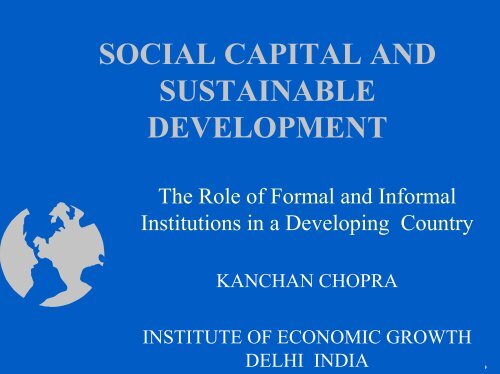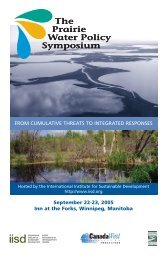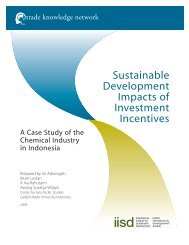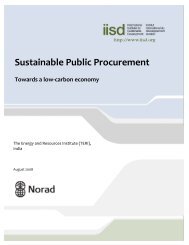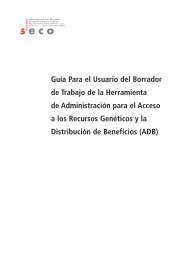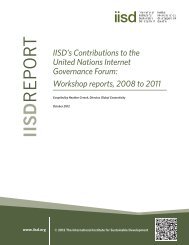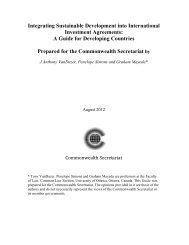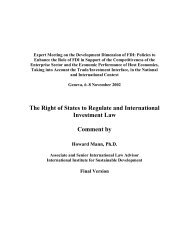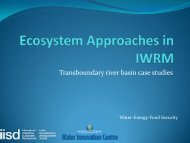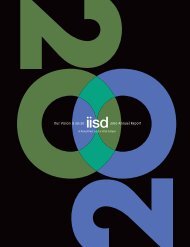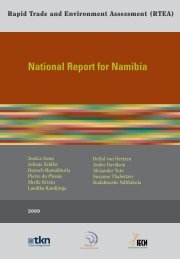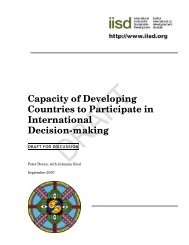The Role of Formal and Informal Institutions in a Developing Country ...
The Role of Formal and Informal Institutions in a Developing Country ...
The Role of Formal and Informal Institutions in a Developing Country ...
You also want an ePaper? Increase the reach of your titles
YUMPU automatically turns print PDFs into web optimized ePapers that Google loves.
<strong>The</strong> <strong>Role</strong> <strong>of</strong> <strong>Formal</strong> <strong>and</strong> <strong>Informal</strong><br />
<strong>Institutions</strong> <strong>in</strong> a Develop<strong>in</strong>g <strong>Country</strong><br />
KANCHAN CHOPRA<br />
INSTITUTE OF ECONOMIC GROWTH<br />
DELHI INDIA
• Social Capital: the Networks <strong>and</strong> Relationships<br />
that shape the quality <strong>and</strong> quantity <strong>of</strong> a society’s<br />
social <strong>in</strong>teractions<br />
• Or the Density <strong>of</strong> <strong>Formal</strong> <strong>and</strong> <strong>Informal</strong><br />
<strong>Institutions</strong> for Development<br />
• <strong>The</strong> Rules that govern Interaction between<br />
Agents<br />
• Social Capital <strong>Formal</strong>izes the role <strong>of</strong> <strong>Institutions</strong><br />
<strong>in</strong> Development Processes<br />
1 2
• State-Society Synergy as Catalyst (Evans1996)<br />
• Co-Production with Complementarity between<br />
agents <strong>in</strong> different sectors (Ostrom1996)<br />
• Evolution <strong>of</strong> Rules <strong>and</strong> Processes is the<br />
Consequence <strong>of</strong> this Interaction<br />
• Development Viewed as an Evolv<strong>in</strong>g Process<br />
1 3
• <strong>The</strong> Concept <strong>of</strong> Susta<strong>in</strong>able Development : Intergenerational<br />
Focus: Also focuses on development with<br />
environmental conservation<br />
• Macro applications are somewhat counter productive)<br />
• It derives its relevance for Poverty Alleviation<br />
Initiatives from a Regional <strong>and</strong> Sectoral focus<br />
• Such a Focus <strong>of</strong> Susta<strong>in</strong>able Development Initiatives<br />
illustrates the <strong>Role</strong> as also the limitations <strong>of</strong> Self-<br />
Evolv<strong>in</strong>g Institutional Networks<br />
1 4
• Traditional Sectors: Government, Civil Society<br />
<strong>and</strong> Markets<br />
• One possible measure <strong>of</strong> Social Capital: Extent<br />
<strong>of</strong> Reach<strong>in</strong>g Out between Agents <strong>in</strong> Sectors<br />
• This is critical to development Processes<br />
• In particular, to Processes that use Natural<br />
Capital based development to alleviate Poverty<br />
1 5
• Natural Resource Based Initiatives for Susta<strong>in</strong>able<br />
Development need Institutional Evolution because<br />
• they need to solve the “free rider problem”<br />
• they need to reckon with the “myopia <strong>and</strong> high<br />
discount<strong>in</strong>g <strong>of</strong> future “ at the outset<br />
• A build<strong>in</strong>g up on Traditional <strong>Institutions</strong> through a<br />
“reach<strong>in</strong>g out <strong>of</strong> agents across sectors” is critical <strong>in</strong> this<br />
process<br />
• However, limitations arise <strong>of</strong>ten due to an <strong>in</strong>terface<br />
with “formal <strong>in</strong>stitutions”<br />
1 6
1 7
• Pool<strong>in</strong>g Resources for Development: A Study<br />
<strong>in</strong> Eastern India<br />
• Break<strong>in</strong>g the Degradation-Migration L<strong>in</strong>k: A<br />
Study <strong>in</strong> Western India<br />
• Harness<strong>in</strong>g Livelihood- Natural resource<br />
L<strong>in</strong>kages for Poverty-Alleviation <strong>in</strong> Northern<br />
India<br />
1 8
• <strong>The</strong> Region:” One <strong>of</strong> the poorest <strong>in</strong> India with unused<br />
l<strong>and</strong> <strong>and</strong> water<br />
• A Small NGO found that under-utilization <strong>of</strong> l<strong>and</strong><br />
<strong>and</strong> water was due to absence <strong>of</strong> a m<strong>in</strong>imum scale <strong>of</strong><br />
operation<br />
• Creat<strong>in</strong>g an appropriate Scale:<br />
• Pool<strong>in</strong>g <strong>of</strong> Privately held l<strong>and</strong> was the first step:<br />
Undertaken by build<strong>in</strong>g on Local <strong>in</strong>stitutions: the<br />
<strong>in</strong>itiations: an urban based NGO<br />
1 9
• Technology for Soil <strong>and</strong> Water Management:<br />
Evolved with <strong>in</strong>puts from regional research<br />
stations, local knowledge etc.<br />
• A three tier system with different gestation<br />
periods to meet the <strong>in</strong>ter-temporal preference<br />
patterns <strong>and</strong> needs<br />
• F<strong>in</strong>ancial Resources: From government <strong>and</strong><br />
semi-government agencies<br />
1 10
• Prior Determ<strong>in</strong>ation <strong>of</strong> Shar<strong>in</strong>g Mechanisms:<br />
another critical <strong>in</strong>put <strong>of</strong> non-governmental<br />
Organisation<br />
• Evolved through Interaction with stakeholders:<br />
workers, owners <strong>of</strong> resources <strong>and</strong> re<strong>in</strong>vestment<br />
needs<br />
• Keep<strong>in</strong>g local needs <strong>in</strong> view: e.g. for<br />
consumption loans (after community<br />
endorsement) catered 1for<br />
11
• A model<strong>in</strong>g was undertaken:<br />
• Conditions for development <strong>and</strong> Limitations:<br />
• Level <strong>of</strong> Initial Physical <strong>and</strong> F<strong>in</strong>ancial Resources<br />
• Work<strong>in</strong>g <strong>of</strong> Institutional Mechanisms for Shar<strong>in</strong>g:<br />
Integration with local aspirations<br />
• Opportunities Outside the Region<br />
• Rates <strong>of</strong> Depreciation <strong>of</strong> Capital, both natural <strong>and</strong><br />
physical <strong>and</strong> Arrangements for Replacement<br />
1 12
• First Phase succeeded <strong>in</strong> poverty alleviation<br />
with natural resource use <strong>in</strong> a limited sense<br />
• Next Phase should be a Scal<strong>in</strong>g Up: l<strong>in</strong>k with<br />
markets for process<strong>in</strong>g <strong>and</strong> sale <strong>of</strong> some<br />
products with a market dem<strong>and</strong><br />
• Inputs <strong>in</strong>to this: Upgrad<strong>in</strong>g <strong>of</strong> human capital<br />
with skills<br />
• A New Dose <strong>of</strong> “Social Entrepreneurship”<br />
1 13
• Region <strong>in</strong> Western India characterised by<br />
“Distress” Migration <strong>in</strong> search <strong>of</strong> Urban<br />
Employment decreas<strong>in</strong>g <strong>in</strong>comes attributed to<br />
deplet<strong>in</strong>g natural resource base<br />
• Local networks supported by NGO’s worked to<br />
create well-specified property rights<br />
1 14
• An Econometric Exploration us<strong>in</strong>g cross-section<br />
data at different levels: district <strong>and</strong> village level<br />
• It was found that Out-migration decreased when<br />
“ rules for protection <strong>and</strong> for shar<strong>in</strong>g the results<br />
<strong>of</strong> protection <strong>of</strong> the commons were well<br />
specified<br />
• Took a time <strong>of</strong> six to eight years<br />
1 15
• Reach<strong>in</strong>g out Across Agents <strong>in</strong> Different<br />
Sectors aga<strong>in</strong> <strong>in</strong> Evidence<br />
• NGO’s with Urban Roots but Long Interaction<br />
with Rural Groups<br />
• Successful Interventions build on Natural<br />
Capital Base for Livelihood Creation<br />
• Build<strong>in</strong>g on Traditions <strong>of</strong> Mutual Help<br />
• F<strong>in</strong>ance from Donor Agencies <strong>and</strong>/ or<br />
Government<br />
1 16
• Spread Effects <strong>of</strong> the Experiment led to a<br />
Dem<strong>and</strong> for Replication<br />
• NGO left the replication to Local Communities<br />
• Build<strong>in</strong>g on Local Mores resulted <strong>in</strong> a Clash<br />
with the Rights <strong>of</strong> “Outsiders” with formal legal<br />
access<br />
• Rights vested <strong>in</strong> formal legal <strong>in</strong>stitutions <strong>and</strong><br />
Local Perceptions may not be consistent<br />
1 17
• Experiment <strong>in</strong> the Himalayan foothills <strong>in</strong> the<br />
north Indian State <strong>of</strong> Haryana<br />
• External effect <strong>of</strong> Soil Erosion on downstream<br />
water-bodies as well as on private farml<strong>and</strong> <strong>in</strong><br />
villages<br />
• Similar Reach<strong>in</strong>g out across agents <strong>in</strong> different<br />
sectors resulted <strong>in</strong> some success over more than a<br />
decade<br />
1 18
• Critical Input <strong>in</strong> this case came from a<br />
government <strong>of</strong>ficial whose <strong>in</strong>itiative, based on a<br />
governmental order, provided user rights on<br />
forest l<strong>and</strong> to villagers<br />
• Protection <strong>of</strong> watershed with shar<strong>in</strong>g<br />
mechanisms worked <strong>and</strong> protected trees were<br />
ready for harvest<strong>in</strong>g<br />
• Nature <strong>of</strong> right to them questioned by new<br />
<strong>in</strong>cumbents <strong>in</strong> state government <strong>in</strong> the n<strong>in</strong>eties:<br />
some fifteen years later<br />
1 19
• A mean<strong>in</strong>gful def<strong>in</strong>ition <strong>of</strong> Social Capital for<br />
Poverty Alleviation needs to dist<strong>in</strong>guish<br />
between <strong>Formal</strong> <strong>and</strong> <strong>Informal</strong> <strong>Institutions</strong>?<br />
• What is the appropriate Degree <strong>of</strong><br />
Decentralization?<br />
• Should Innovative Interpretations <strong>of</strong> Larger<br />
<strong>Formal</strong>ized Legal Rules be accompanied with a<br />
process <strong>of</strong> change <strong>in</strong> formal centralized<br />
<strong>in</strong>stitutions?<br />
1 20
• What is the role <strong>of</strong> Human Capital Formation?<br />
• Should education enable or empower<br />
Communities to achieve Vertical Integration <strong>of</strong><br />
Local Developmental Interventions with the<br />
market<br />
• How do “social entrepreneurs” emerge?<br />
1 21
• Why is there a dearth <strong>of</strong> “social capital” <strong>of</strong> the<br />
<strong>in</strong>formal k<strong>in</strong>d <strong>in</strong> urban contexts?<br />
• Is the Density <strong>of</strong> <strong>Informal</strong> Networks associated<br />
with the Interactions between people <strong>in</strong><br />
livelihood generation?<br />
• With deterioration <strong>of</strong> urban environments, what<br />
role can formal legal, f<strong>in</strong>ancial <strong>and</strong> market<br />
<strong>in</strong>stitutions play <strong>in</strong> “susta<strong>in</strong>able urban<br />
development”?<br />
1 22


